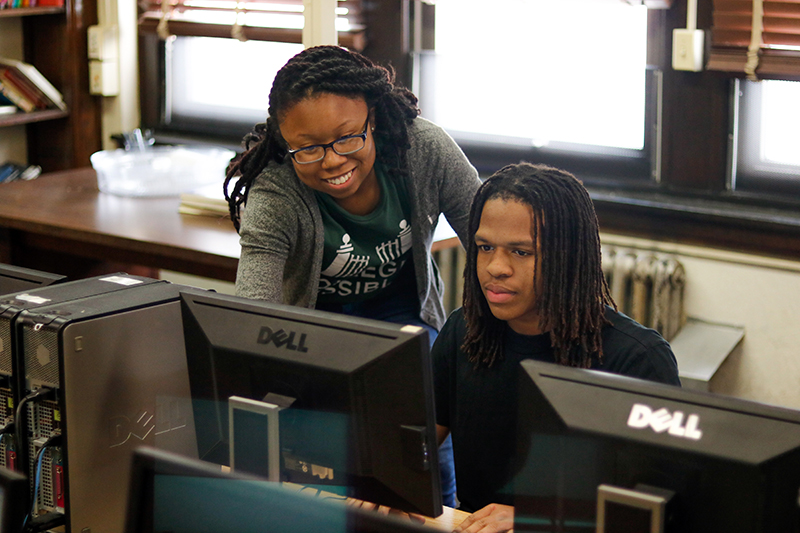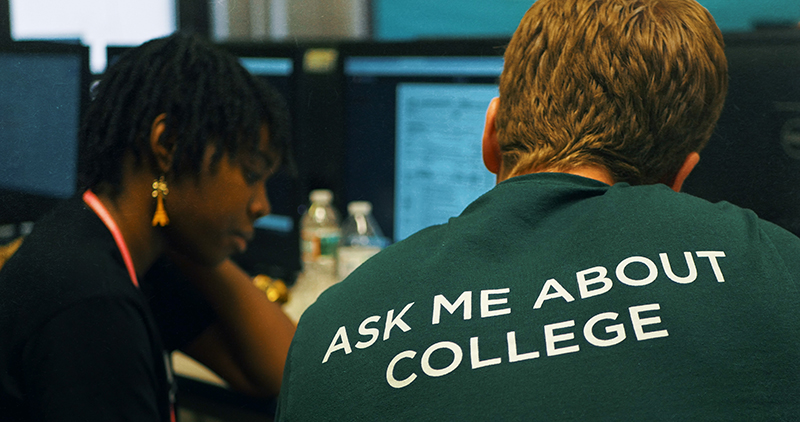
Ian Reitz
College Possible coaches are embedded in schools and work with students during the day and after school. Here, coach Keyana Moody (left) looks over a college application with high school senior Hezekiah, a student at the Philadelphia high school Parkway Center City Middle College.
When Camellia Brown was growing up in Philadelphia, she was an avid reader.
She knew she wanted to go to college. But the process of getting there was complex — and how would she pay for it?
No one in her family had attended college. Her mother worked as a crossing guard to support Camellia and two siblings. They lived in public housing.
Far too many students face the same challenges.
More than one-fifth of youngsters under 18 live in families who are below the poverty threshold. One-fourth of American college students are the first generation in their family to attend college.
Low-income, first-generation college students and students of color face barriers to college. They enroll at a lower rate and graduate at a lower rate.
In 2017, 82 percent of low-income students taking the ACT said they’d like to pursue a bachelor’s degree or graduate degree, according to the ACT testing organization. Only 66 percent actually enrolled.
These students tend to lack rigorous academic preparation, adequate counseling support in high school and financial support when they get to college, Laura Perna, executive director of the University of Pennsylvania Alliance for Higher Education and Democracy, told Education Week last year.
For Brown, a college advising program called College Possible helped fill the gap.
“It helped me stay motivated,” she said. Her coach provided information and assistance that her mother did not necessarily have.
College Possible has operated in Philadelphia for five years and works in six high schools. In 2018, the organization coached 260 high school graduates who went to college.
“We provide a near-peer coach,” said Jen Weikert, executive director of College Possible in Philadelphia.

[ 2 one 5 ] Creative
Camellia Brown, who graduated from Parkway Center City Middle College High School last year, reviews a scholarship application with her coach Jacob Van Houten.
Continued support after entry
Coaches are recent college graduates who are serving with AmeriCorps. Embedded in high schools, they provide college advising to supplement the work of high school guidance counselors. Not only are there too few guidance counselors nationwide — the ratio is 482 students per counselor — but those in high-poverty schools are stretched thin dealing with the impact of poverty, Weikert said.
College Possible coaches meet with students during school hours and after school Monday through Thursday. They help students raise their SAT scores, apply for college and get financial aid.
Brown did SAT test preparation and, with her coach’s guidance, applied for 10 scholarships. She received a small scholarship along with financial aid. She also applied to and got into a college she wasn’t sure she could attain — Temple University. She’s now a freshman there studying public relations.
College Possible coaches not only work with high school juniors and seniors, but continue advising and coaching the students through their years in college.
They reach out to college students through text, phone, Facebook, SnapChat or other means. They send reminders of financial aid and registration deadlines and help students deal with problems and concerns. Students often struggle with time management in college, Weikert said.
A coach’s continued support has been important to Brown since she’s been at Temple. Brown said her mother doesn’t necessarily understand the challenges of being a freshman. But her coach does.
College Possible also has branches in Chicago; Milwaukee; Omaha, Neb.; Portland, Ore., and areas of Minnesota. Last year it served 19,000 high school and college students across the nation, according to the organization.



























